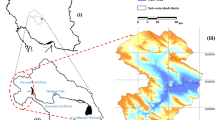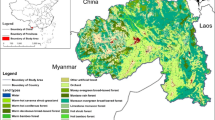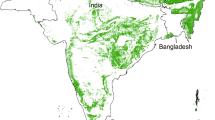Abstract
Mountains in western China, hosted rich biodiversity and millions of people and inhabitant with vital ecosystem services, had experienced the most serious biodiversity loss with fragile ecological problems. Even though increasing attentions had been paid to this issue, we still lacked efficient methods to assess the change of plant biodiversity at medium/large scale due to the poor data and co-existing multiple habitat types. This study proposed an integrated method combining InVEST-habitat quality model, NPP and landscape pattern indexes to analyze the spatial heterogeneity of plant biodiversity and its spatiotemporal change on raster cell scale. The results indicated that plant biodiversity service was high in Bailongjiang watershed with obvious spatial pattern variations. The land area containing higher plant biodiversity were 3161 km2, which mainly distributed in the National Nature Reserve and forestry area. While the areas with lower plant biodiversity accounted for 37.67% and mainly distributed in the valleys between Zhouqu-Wudu-Wenxian County, the valley of Minjiang in Tanchang County and alpine mountain snow-covered regions. During 1990–2010, plant biodiversity level tended to increase and the higher plant biodiversity area increased from 14.13% to 17.15% due to ecological restoration and afforestation, while plant biodiversity decreased in the area with intensive human activities, such as cultivated land, urban and rural land. The results showed that combining InVEST-habitat quality model, NPP and landscape pattern indexes can effective reveal mountain plant biodiversity change. The study was useful for plant biodiversity conservation policy-making and human activity management for the disaster-impacted mountainous areas in China.
Similar content being viewed by others
References
Baral H, Keenan R J, Sharma S K et al., 2014. Spatial assessment and mapping of biodiversity and conservation priorities in a heavily modified and fragmented production landscape in north-central Victoria, Australia. Ecological Indicators, 36: 552–562.
Batáry P, Holzschuh A, Orci K M et al., 2012. Responses of plant, insect and spider biodiversity to local and landscape scale management intensity in cereal crops and grasslands. Agriculture, Ecosystems & Environment, 146(1): 130–136.
Boykin K G, Kepner W G, Bradford D F et al., 2013. A national approach for mapping and quantifying habitat-based biodiversity metrics across multiple spatial scales. Ecological Indicators, 33: 139–147.
Buckland S T, Johnston A, 2017. Monitoring the biodiversity of regions: Key principles and possible pitfalls. Biological Conservation, 214: 23–34.
Butchart S H M, Walpole M, Collen B et al., 2010. Global biodiversity: Indicators of recent declines. Science, 328(5982): 1164–1168.
Chaplin-Kramer R, Sharp R P, Mandle L et al., 2015. Spatial patterns of agricultural expansion determine impacts on biodiversity and carbon storage. Proceedings of the National Academy of Sciences of the United States of America, 112(24): 7402–7407.
Chen Y, Qiao F, Jiang L, 2016. Effects of land use pattern change on regional scale habitat quality based on InVEST model: A case study in Beijing. Acta Scientiarum Naturalium Universitatis Pekinensis, 52(3): 553–562. (in Chinese)
Convertino M, Kiker G A, Muñoz-Carpena R et al., 2011. Scale- and resolution-invariance of suitable geographic range for shorebird metapopulations. Ecological Complexity, 8(4): 364–376.
de Chazal J, Rounsevell M D A, 2009. Land-use and climate change within assessments of biodiversity change: A review. Global Environmental Change, 19(2): 306–315.
Ding L, Sun X G, Liu X J et al., 2006. Species diversity and floristic characteristics of seed plants in the middle-upper reaches of the Bailong River. Journal of Gansu Agricultural University, 41(6): 79–85. (in Chinese)
Du P J, Xia J S, Xue Z H et al., 2016. Review of hyperspectral remote sensing image classification. Journal of Remote Sensing, 20(2): 236–256. (in Chinese)
Fahrig L, 2003. Effects of habitat fragmentation on biodiversity. Annual Review of Ecology and Systematicas, 34: 487–515.
Garcia-Llamas P, Calvo L, De la Cruz M et al., 2018. Landscape heterogeneity as a surrogate of biodiversity in mountain systems: What is the most appropriate spatial analytical unit? Ecological Indicators, 85: 285–294.
Gong J, Zhao C X, Xie Y C et al., 2014. Ecological risk assessment and its management of Bailongjiang watershed, southern Gansu based on landscape pattern. Chinese Journal of Applied Ecology, 25(7): 2041–2048. (in Chinese)
Guiomar N, Godinho S, Fernandes P M et al., 2015. Wildfire patterns and landscape changes in Mediterranean oak woodlands. Science of the total Environments, 536: 338–352.
Guo X, Coops N C, Tompalski P et al., 2017. Regional mapping of vegetation structure for biodiversity monitoring using airborne Lidar data. Ecological Informatics, 38: 50–61.
Guo Z G, Liu H X, Sun X G et al., 2003. Characteristics of species diversity of plant communities in the upper reaches of Bailong River. Acta Phytoecologica Sinica, 27(3): 388–395. (in Chinese)
Haines-Young R H, 2009. Land use and biodiversity relationships: Land use futures. Land Use Policy, 26 (Suppl.1): S178–S186.
Isbell F, Reich P B, Tilman D et al., 2013. Nutrient enrichment, biodiversity loss, and consequent declines in ecosystem productivity. Proceedings of the National Academy of Sciences of the United States of America, 110(29): 11911–11916.
John R, Chen J Q, Lu N et al., 2008. Predicting plant diversity based on remote sensing products in the semi-arid region of Inner Mongolia. Remote Sensing of Environment, 112(5): 2018–2032.
Kohsaka R, Pereira H, Elmqvist T et al., 2013. Indicators for management of urban biodiversity and ecosystem services: City biodiversity index. In: Urbanization, Biodiversity and Ecosystem Services: Challenges and Opportunities. New York: Springer, 699–718.
Lausch A, Bannehr L, Beckmann M et al., 2016. Linking earth observation and taxonomic, structural and functional biodiversity: Local to ecosystem perspectives. Ecological Indicators, 70: 317–339.
Li B, Zeng T, Ran J H et al., 2017. Characteristics of the early secondary succession after landslides in a broad-leaved deciduous forest in the south Minshan Mountains. Forest Ecology and Management, 405: 238–245.
Li J, Cui Y P, Liu J Y et al., 2013. Estimation and analysis of net primary productivity by integrating MODIS remote sensing data with a light use efficiency model. Ecological Modelling, 252: 3–10.
Li Y H, Xiang B, Yuan X Z et al., 2012. Characteristics of biodiversity spatial differentiation in the Chengdu-Chongqing economic zone. Research of Environmental Sciences, 25(10): 1148–1154. (in Chinese)
Liang Y J, Liu L J, 2017. Simulating land-use change and its effect on biodiversity conservation in a watershed in northwest China. Ecosystem Health and Sustainability, 3(5): 1–10.
Liddicoat C, Bi P, Waycott M et al., 2018. Landscape biodiversity correlates with respiratory health in Australia. Journal of Environmental Management, 206: 113–122.
Liu C Y, Dong X F, Liu Y Y, 2015. Changes of NPP and their relationship to climate factors based on the transformation of different scales in Gansu, China. Catena, 125: 190–199.
Ma K P, Shen X L, Grumbine R E et al., 2017. China’s biodiversity conservation research in progress. Biological Conservation, 210(B): 1–2.
MA, 2005. Ecosystems and Human Wellbeing: Current State and Trends. Millennium Ecosystem Assessment Series, Vol.1, 96 pp., Washington, DC.
Mitchell M, Lockwood M, Moore S A et al., 2015. Scenario analysis for biodiversity conservation: A social-ecological system approach in the Australian Alps. Journal of Environmental Management, 150: 69–80.
Murguia D I, Bringezu S, Schaldach R, 2016. Global direct pressures on biodiversity by large-scale metal mining: Spatial distribution and implications for conservation. Journal of Environmental Management, 180: 409–420.
Nagendra H, Lucas R, Honrado J P et al., 2013. Remote sensing for conservation monitoring: assessing protected areas, habitat extent, habitat condition, species diversity, and threats. Ecological Indicators, 33: 45–59.
Nelson J E, Mendoza G, Regetz J et al., 2009. Modeling multiple ecosystem services, biodiversity conservation, commodity production, and tradeoffs at landscape scales. Frontiers in Ecology and the Environment, 7(1): 4–11.
Ng C N, Xie Y J, Yu X J, 2013. Integrating landscape connectivity into the evaluation of ecosystem services for biodiversity conservation and its implications for landscape planning. Applied Geography, 42: 1–12.
Ouyang Z Y, Zheng H, Xiao Y et al., 2016. Improvements in ecosystem services from investments in natural capital. Science, 352(6292): 1455–1459.
Payne D, Spehn E M, Snethlage M et al., 2017. Opportunities for research on mountain biodiversity under global change. Current Opinion in Environmental Sustainability, 29: 40–47.
Peng Y, Qing F T, Mi K et al., 2015. Study progress on spatial scale effects and coupling relationships of different levels in biodiversity. Acta Ecologica Sinica, 35(2): 577–583. (in Chinese)
Plexida S G, Sfougaris A I, Ispikoudis I P, 2014. Selecting landscape metrics as indicators of spatial heterogeneity: A comparison among Greek landscapes. International Journal of Applied Earth Observation and Geoinformation, 26: 26–35.
Polasky S, Nelson E, Pennington D et al., 2011. The impact of land-use change on ecosystem services, biodiversity and returns to landowners: A case study in the state of Minnesota. Environmental and Resource Economics, 48(2): 219–242.
Qiu Z Q, Yang Y H, Cao X W et al., 2007. Species diversity and floristic characteristics of woody plants in the dry valley of the Bailong River, China. Journal of Gansu Agricultural University, 42(10): 119–125. (in Chinese)
Remme RP, Hein L, van Swaay C A M, 2016. Exploring spatial indicators for biodiversity accounting. Ecological Indicators, 70: 232–248.
Rossi J P, van Halder I, 2010. Towards indicators of butterfly biodiversity based on a multiscale landscape description. Ecological Indicators, 10(2): 452–458.
Sallustio L, De Toni A, Strollo A et al., 2017. Assessing habitat quality in relation to the spatial distribution of protected areas in Italy. Journal of Environmental Management, 201: 129–137.
Santini L, Belmaker J, Costello M J et al., 2017. Assessing the suitability of diversity metrics to detect biodiversity change. Biological Conservation, 213: 341–350.
Santos M, Ferreira D, Bastos R et al., 2016. Linking landscape futures with biodiversity conservation strategies in northwest Iberia: A simulation study combining surrogates with a spatiotemporal modelling approach. Ecological Informatics, 33: 85–100.
Schindler S, von Wehrden H, Poirazidis K et al., 2013. Multiscale performance of landscape metrics as indicators of species richness of plants, insects and vertebrates. Ecological Indicators, 31: 41–48.
Scholes R J, Walters M, Turak E et al., 2012. Building a global observing system for biodiversity. Current Opinion in Environmental Sustainability, 4(1): 139–146.
Sun Q, Zhang L, Ding X L et al., 2015. Slope deformation prior to Zhouqu, China landslide from InSAR time series analysis. Remote Sensing of Environment, 156: 45–57.
Tallis H T, Ricketts T, Guerry A et al., 2013. InVEST 2.5.6 User’s Guide. Stanford: The Natural Capital Project.
Tang C W, Sun X G, Xiao D N, 2005. Priority area assessment for species diversity conservation of spermatophytic genera endemic to China in Gansu Province. Chinese Journal of Ecology, 24(10): 1127–1133. (in Chinese)
Terrado M, Sabater S, Chaplin-Kramer B et al., 2016. Model development for the assessment of terrestrial and aquatic habitat quality in conservation planning. Science of the total Environments, 540: 63–70.
Turner M G, Gardner R H, 2015. Landscape Ecology in Theory and Practice. 2nd ed. New York: Springer.
Turner W, 2014. Sensing biodiversity. Science, 346(6207): 301–302.
Turner W, Rondinini C, Pettorelli N et al., 2015. Free and open-access satellite data are key to biodiversity conservation. Biological Conservation, 182: 173–176.
Turner W, Spector S, Gardiner N et al., 2003. Remote sensing for biodiversity science and conservation. Trends in Ecology & Evolution, 18(6): 306–314.
UNEP (United Nations Environment Programme), 2010. What is biodiversity? https://doi.org/www.unesco.pl/filead-min/user_upload/pdf/BIODIVERSITY_FACTSHEET.pdf.
Urbazaev M, Thiel C, Mathieu R et al., 2015. Assessment of the mapping of fractional woody cover in southern African savannas using multi-temporal and polarimetric ALOS PALSAR L-band images. Remote Sensing Environment, 166: 138–153.
Vihervaara P, Auvinen A P, Mononen L et al., 2017. How essential biodiversity variables and remote sensing can help national biodiversity monitoring. Global Ecology and Conservation, 10: 43–59.
Walz U, Syrbe R U, 2013. Linking landscape structure and biodiversity. Ecological Indicators, 31: 1–5.
Wang G X, Liu G H, Shen Z H et al., 2017. Research progress and future perspectives on the landscape ecology of mountainous areas. Acta Ecologica Sinica, 37(12): 3967–3981. (in Chinese)
Wang H, Liu G H, Li Z S et al., 2016. Impacts of climate change on net primary productivity in arid and semiarid regions of China. Chinese Geographical Sciences, 26(1): 35–47.
Wilson M C, Chen X Y, Corlett R T et al., 2016. Habitat fragmentation and biodiversity conservation: Key findings and future challenges. Landscape Ecology, 31: 219–227.
Wu J Y, Xue D Y, Wang A H et al., 2016. Case studies on the identification of key biodiversity areas (KBAs) in foreign countries and progress and prospects in China. Acta Ecologica Sinica, 36(10): 3108–3114. (in Chinese)
Xie Y C, Gong J, Qi S S et al., 2017. Assessment and spatial variation of biodiversity in the Bailong River Watershed of the Gansu Province. Acta Ecologica Sinica, 37(19): 6448–6456. (in Chinese)
Xu P, Wang Y K, Yang J F et al., 2013. Identification of hotspots for biodiversity conservation in the Wenchuan earthquake-hit area. Acta Ecologica Sinica, 33(3): 718–725. (in Chinese)
Zhang Y B, Wang Y Z, Phillips N et al., 2017. Integrated maps of biodiversity in the Qinling Mountains of China for expanding protected areas. Biological Conservation, 210: 64–71.
Zhang Y L, Qi W, Zhou C P et al., 2014. Spatial and temporal variability in the net primary production of alpine grassland on the Tibetan Plateau since 1982. Journal of Geographical Sciences, 24(2): 269–287.
Zhao C X, 2012. Ecological risk assessment in the Bailongjiang watershed in southern Gansu [D]. Lanzhou: Lanzhou University. (in Chinese)
Zhao G S, Liu J Y, Kuang W H et al., 2015. Disturbance impacts of land use change on biodiversity conservation priority areas across China: 1990–2010. Journal of Geographical Sciences, 25(5): 515–529.
Zheng Z, Gong D J, Zhang Q et al., 2014. Vertical patterns of plant species diversity in the Baishuijiang Nature Reserve: Explanation of area, climate and boundary constraint. Chinese Journal of Applied Ecology, 25(12): 3390–3398. (in Chinese)
Acknowledgments
We owe a great debt to Dr. Zehao Shen, an excellent researcher of biodiversity and landscape ecology of Peking University, Dr. Vanessa Hull, an assistant professor of University of Florida, USA with research interests on landscape ecology and natural conservation for assistance on the improvement of data analysis and English writing. Finally, we would like to thank the anonymous reviewers and the editors for their helpful comments that improved the manuscript substantially.
Author information
Authors and Affiliations
Corresponding author
Additional information
Foundation: National Natural Science Foundation of China, No. 41771196, No. 41761039, No. 41271199
Author: Gong Jie, PhD and Associate Professor, specialized in landscape ecology, land change science and ecosystem service.
Rights and permissions
About this article
Cite this article
Gong, J., Xie, Y., Cao, E. et al. Integration of InVEST-habitat quality model with landscape pattern indexes to assess mountain plant biodiversity change: A case study of Bailongjiang watershed in Gansu Province. J. Geogr. Sci. 29, 1193–1210 (2019). https://doi.org/10.1007/s11442-019-1653-7
Received:
Accepted:
Published:
Issue Date:
DOI: https://doi.org/10.1007/s11442-019-1653-7




